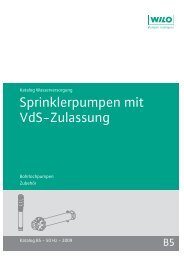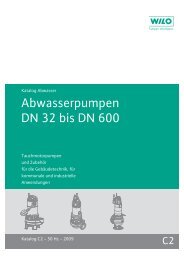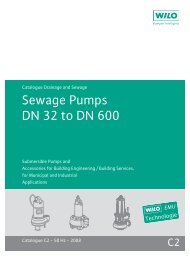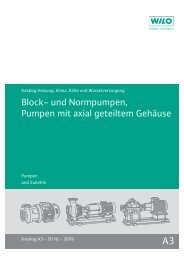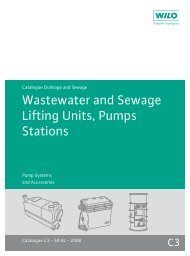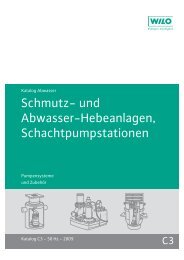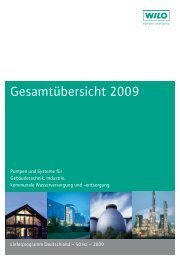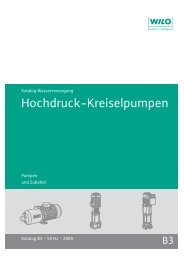Refrigeration, air-conditioning and cooling technology - 2007.pdf
Refrigeration, air-conditioning and cooling technology - 2007.pdf
Refrigeration, air-conditioning and cooling technology - 2007.pdf
Create successful ePaper yourself
Turn your PDF publications into a flip-book with our unique Google optimized e-Paper software.
PLH_KKK_U2_31.QXP 25.05.2007 11:01 Uhr Seite 15FUNDAMENTALSPumping of viscous mediaThe representation of the pump capacity data inthe Q vs. H diagram also usually refers to wateras the fluid, as in the calculation of the systemcurve, with a kinematic viscosity of ν = 1 mm 2 /s.The pump data changes for fluids of other viscosities<strong>and</strong> densities. The data correction whichshould be done even for hot water pumping tobe correct can be neglected in building engineering.There only has to be a check for seriouschanges (more than 10% volume percentage)in the water when additives are used, such asglycol, etc. Hereby, it is to be observed that theplanning of pump systems, <strong>and</strong> thus the determinationof the pump data Q, H, P, is divided upinto two sections for pumping fluids of higherviscosity.• It may only be used when there is a completelyadequate maintained system pressure value(NPSHA) available.The values to be specified for determination are:1. Operating temperature t [°C] of the fluid atthe pump.2. Density ρ [kg/m 3 ] of the fluid at lowest specifiedoperating temperature.3. Kinematic viscosity ν [cSt or mm 2 /s] of thefluid at the lowest specified operating temperature.4.Required volume flow of the fluid Q vis [m 2 /h].5. Required delivery head of the fluid H vis [m].Sample curve for potential changes in a circulating pumpChange in the system curveA correction in the system curve / characteristicsof existing systems calculated for water pumpingfor operation with fluids of other viscosities<strong>and</strong> densities must be done taking the changingflow characteristics into account. These correctionfactors can not be specified by the pumpmanufacturer.The new system curve can be determined withthe help of the relevant flow-related professionalliterature / information from the fittingsmanufacturers.Delivery head H [m]8,07,06,05,04,03,02,01,00,0 1,0 2,0 3,0 4,0 5,0 6,0 7,0 8,0Flow Q [m³/h]Change in the flow rate dueto higher fluid viscosityChange in the pump characteristicsSimilar to how it is in the system, influences onthe frictional moments <strong>and</strong> inner flow conditionsarise in the pump as well due to the changedfluid properties, which, added up, can result ina deviating pump curve. The electric power consumptionof the pump unit is influenced. Sinceindividual measurements of all pumps aren'tfeasible for many possible operating media dueto cost reasons, various conversion methodshave been developed (Hydraulic Institute, pumpmanufacturer, etc.). The methods have limitedprecision <strong>and</strong> are subject to certain restrictions.NotesThe described method is sufficiently accuratefor determining the flow rate for Wilo screwedconnection<strong>and</strong> flange-end pumps when thefollowing basic conditions are complied with:η ges [-]P 1 [W]0.400.350.300.250.200.150.100.050.0 1.0 2.0 3.0 4.0 5.0 6.0 7.0 8.0Flow Q [m³/h]300250200150Change in the efficiency dueto higher fluid viscosity• It may only be used for homogenous Newtonfluids. In the case of muddy, gelatine-likefibre-containing <strong>and</strong> other inhomogeneousfluids, there are strongly scattered results.100500.0 1.0 2.0 3.0 4.0 5.0 6.0 7.0 8.0Flow Q [m³/h]Change in the motor powerdue to higher fluid viscosityWilo Planning Guide - <strong>Refrigeration</strong>, <strong>air</strong>-<strong>conditioning</strong> <strong>and</strong> <strong>cooling</strong> <strong>technology</strong> 02/2007 15



